Restoring 70mm Movie Musical Oklahoma! for a New DCP - at 30fps | Read more at in70mm.com The 70mm Newsletter |
| Written by: Bryant Frazer, studiodaily.com. Reprinted with written permission. First published May 7, 2014 | Date: 24.05.2014 |
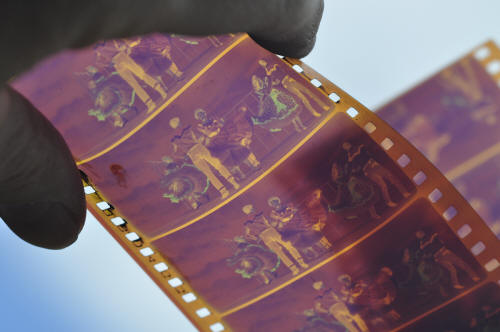 Vintage 65mm negative of "Oklahoma!". This is internegative #5 (IN5) used for the Todd-AO Distortion Correcting Printing Process in Fort Lee, New Jersey, 1956. Click the image to see enlargement. Vintage 65mm negative of "Oklahoma!". This is internegative #5 (IN5) used for the Todd-AO Distortion Correcting Printing Process in Fort Lee, New Jersey, 1956. Click the image to see enlargement.It's not your ordinary Hollywood musical — not only is "Oklahoma!" one of the few films shot in the 65mm Todd-AO format, it's also one of the only Hollywood feature films acquired at a high frame rate. That's right — more than 50 years before "The Hobbit" graced multiplex screens, "Oklahoma!" was one of two Todd-AO titles to be shot at 30fps. (The other, "Around the World in Eighty Days", was released the following year.) As Fox prepped the title for restoration, it decided to honor the film's original frame rate, creating a 30 fps DCP at 4K resolution. The new version was created at FotoKem under the supervision of Schawn Belston, senior VP of library and technical services at Fox Filmed Entertainment. | More in 70mm reading: "Oklahoma!" full credits "Oklahoma!" 70mm Seasons The Samuel Goldwyn Co 1982 re-release of "Oklahoma!" "Oklahoma!" - The First Movie Produced By Todd-AO You are in the Show with Todd-AO Newly Restored Oklahoma! to open TCM Classic Film Festival FotoKem Restores "South Pacific" Internet link: studiodaily.com More 65mm FotoKem Projects Cube Cinema |
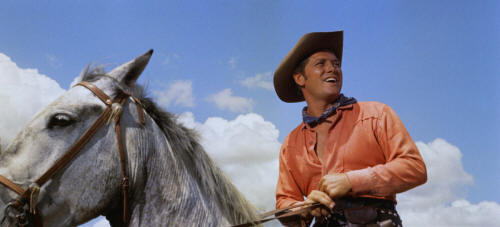 Restored frame blow up from "Oklahoma!". Click the image to see enlargement. Image from 20th Century Fox Restored frame blow up from "Oklahoma!". Click the image to see enlargement. Image from 20th Century FoxThe restoration premiered April 10 at the TCM Classic Film Festival on the big screen at Hollywood's TCL Chinese Theater, but the restoration process actually began about nine years ago. At that time, FotoKem had the opportunity to assess the degraded quality of the film's camera negative, which was badly faded. At that point, Fox asked that a new interpositive (IP) be made. It wouldn't reverse the damage to the original negative, but it would create a good copy reflecting the condition of the negative at that point in time. When FotoKem embarked on the new restoration, it used that timed 65mm IP as a starting point, scanning it at 8K on an Imagica scanner — one of only two such scanners in existence, according to FotoKem's Andrew Oran, VP of sales and operations, large format and restoration. | |
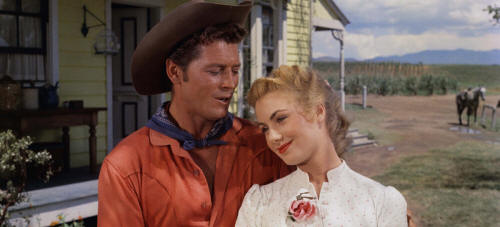 Restored frame blow up from "Oklahoma!". Click the image to see enlargement. Image from 20th Century Fox Restored frame blow up from "Oklahoma!". Click the image to see enlargement. Image from 20th Century Fox"The interpositive was an accurate record, or reproduction, of the original negative," Oran told StudioDaily. "It was made wet-gate, so physical damage — some scratching to the original negative — was healed, but just about everything else was photographed in. There was embedded dirt, for example, but especially flicker. Due to the fading of the yellow dye layer on the original negative, and also due to improper processing during the original production, there is a lot of what we would call flicker, or color-breathing, built into the original negative. So one of our biggest challenges was dealing with that." The extensive fading wasn't exactly unexpected. Fading of films shot on Kodak's Eastman Color type 5248 film stock, popular during the 1950s, is common. Another issue was "held dirt spots," Oran said, or spots somehow created by liquid on the glass in front of the camera. FotoKem worked to remove those blotches, as well. Asked about film grain in the image, Oran said the rule is, "We don't touch it." And then he said there is an exception. | |
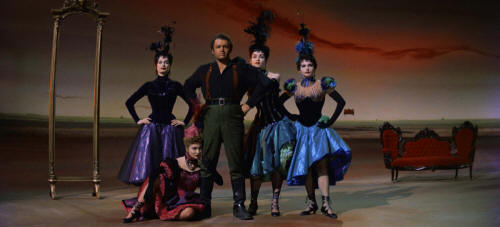 Restored frame blow up from "Oklahoma!". Click the image to see enlargement. Image from 20th Century Fox Restored frame blow up from "Oklahoma!". Click the image to see enlargement. Image from 20th Century Fox"The only time we ever touch grain on one of these classic film restorations is in dealing with the opticals, which are an issue on "Oklahoma!" as they are on most films of that area," he said. "These [optical effects, including dissolves] were made through dupe negative elements on optical printers of the day, they are usually poor quality, and they have a very different grain structure from surrounding shots. All we try to do is adjust the grain slightly on those opticals to make them better match the body of the film. Otherwise we don't touch grain." When it came time to project the new restoration for a paying audience, hardware from Qube Cinema came in handy. Qube's Eric Bergez, director of sales and marketing, says the company has concentrated on special venues, post-production, and giant screens as a way to set itself apart from the competition, coming up with hardware that could move more than the typical amount of data around a projection booth. "30fps isn't really considered high-frame-rate in the 2K world," Bergez told Studio. "You need to be up in the 60s, or the 90s. But we did all this a long time ago — we added quad-3G interfaces for post, so you could do 4K in real time. A lot of Hollywood facilities, like FotoKem and Cinelicious, are using Qube's IMB with quad-3G for 4K DI suites." | |
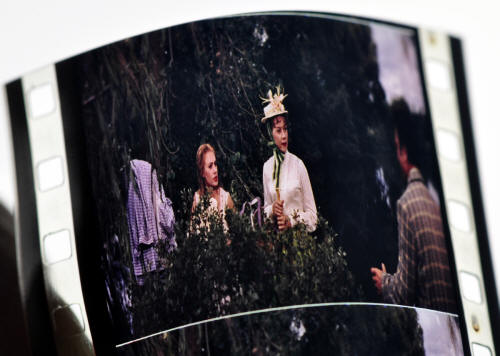 Actual 35mm CinemaScope 4-track magnetic IB Technicolor frame from "Oklahoma!" - badly gone vinegar. Click the image to see enlargement Actual 35mm CinemaScope 4-track magnetic IB Technicolor frame from "Oklahoma!" - badly gone vinegar. Click the image to see enlargementThat made Qube's hardware a natural at the Chinese Theater, where Qube said the new high-bit-rate DCP was streamed at 500 Mbps from a Qube XP-I server to a Qube 4K Xi IMB embedded in the theater's 4K Christie projector. But what effect does the higher frame rate have on the viewer? "That's a very subjective question," says FotoKem's Oran. "To me, the added temporal resolution adds a greater dimensionality to the film — a greater separation between foreground, midground, and background elements, which you notice right off the bat. The film opens with a push through a cornfield and then cuts to Gordon MacRae on his horse, and it's like a window on the plains of Oklahoma, as opposed to a film. I think 30 frames plays a big part in that." In addition to the 4K DCP, FotoKem delivered a 4K archive to LTO tape and an HDCAM SR version for Blu-ray mastering. The results, by the way, are now available for home viewing in a Rodgers and Hammerstein Collection Blu-ray boxed set that was released exclusively through Amazon.com last week. | |
| Go: back - top - back issues - news index Updated 19-03-24 |
